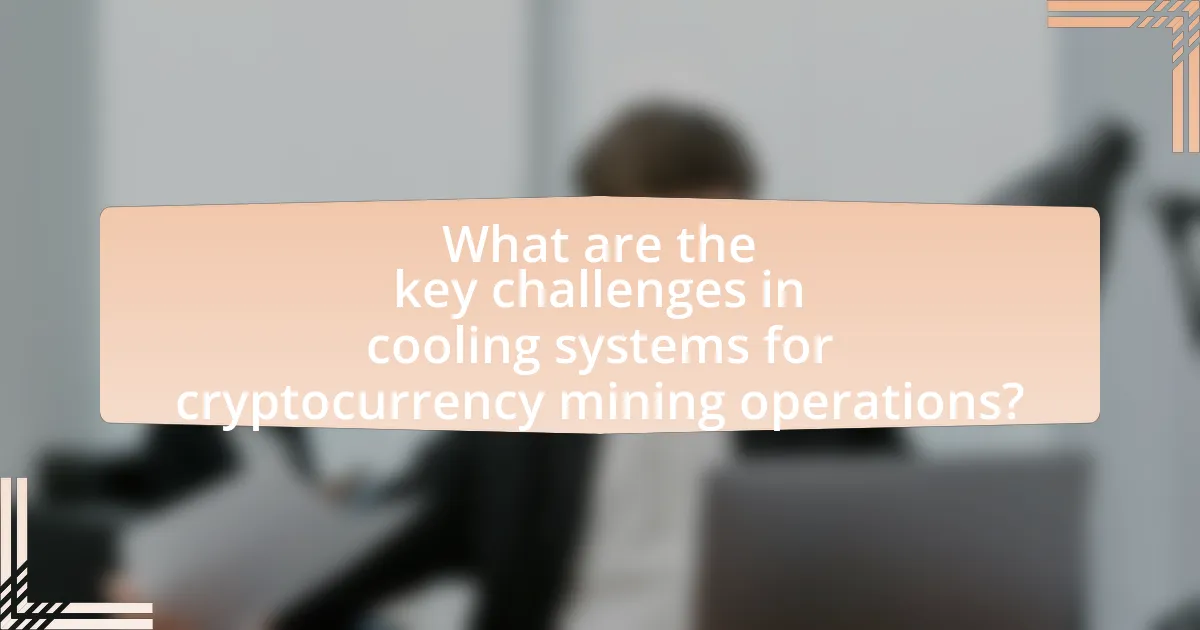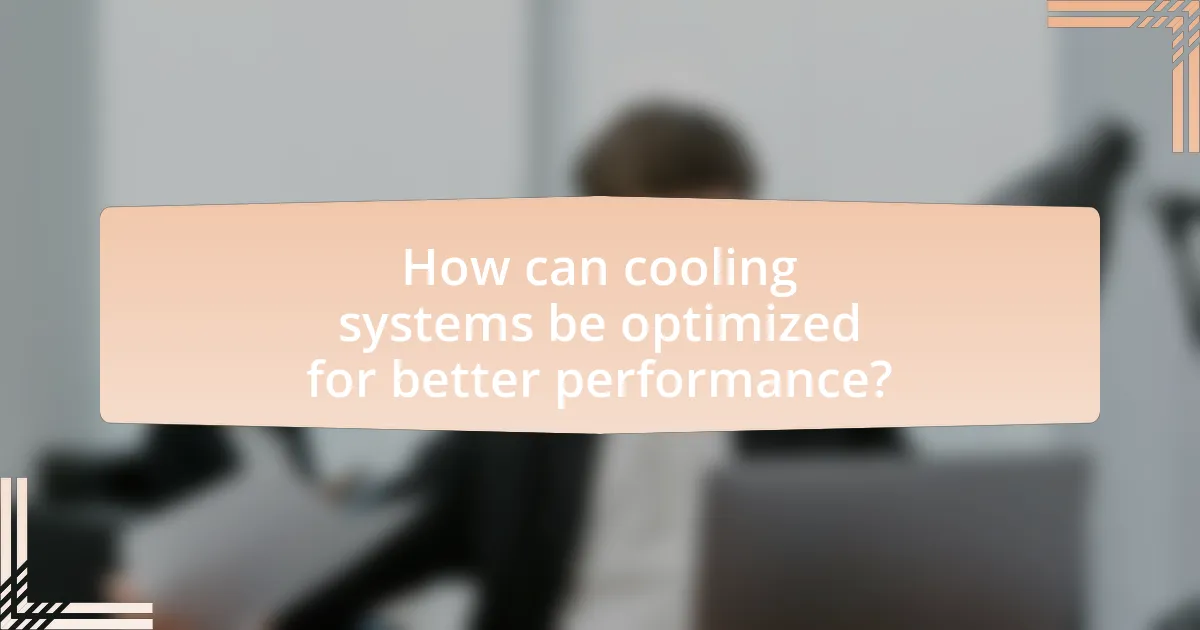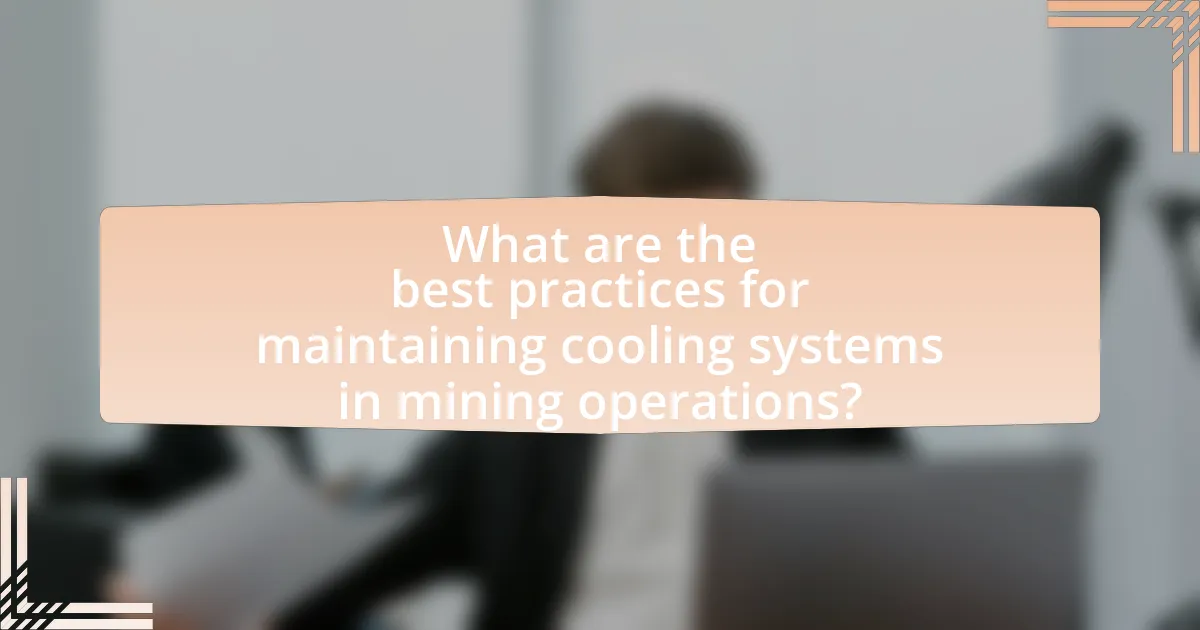The article focuses on optimizing cooling systems for cryptocurrency mining operations, addressing key challenges such as high energy consumption, inadequate heat dissipation, and the need for scalability. It explores the impact of heat generation on mining efficiency, detailing how excessive temperatures can reduce hardware performance and lifespan. Various cooling methods, including air cooling, liquid cooling, and immersion cooling, are examined, along with strategies for enhancing cooling efficiency through advanced technologies and proper maintenance practices. The article emphasizes the importance of effective cooling solutions to ensure the reliability and profitability of mining operations.

What are the key challenges in cooling systems for cryptocurrency mining operations?
The key challenges in cooling systems for cryptocurrency mining operations include high energy consumption, inadequate heat dissipation, and the need for scalability. High energy consumption is a significant issue, as cooling systems can account for up to 30% of the total energy usage in mining facilities, impacting overall profitability. Inadequate heat dissipation can lead to overheating of mining hardware, resulting in reduced performance and potential hardware failure. Additionally, as mining operations expand, the cooling systems must be scalable to accommodate increased heat loads, which can complicate infrastructure planning and increase costs. These challenges necessitate innovative cooling solutions to maintain efficiency and reliability in cryptocurrency mining.
How does heat generation impact mining efficiency?
Heat generation negatively impacts mining efficiency by increasing the operational temperature of mining hardware, which can lead to reduced performance and potential hardware failure. As mining equipment operates at higher temperatures, it may throttle its performance to prevent overheating, resulting in lower hash rates and decreased overall productivity. Studies indicate that for every 10°C increase in temperature, the lifespan of electronic components can decrease significantly, often by 50% or more. Therefore, effective cooling systems are essential to maintain optimal temperatures, ensuring that mining operations run efficiently and sustainably.
What factors contribute to excessive heat in mining rigs?
Excessive heat in mining rigs is primarily caused by high power consumption, inefficient cooling systems, and environmental factors. Mining rigs operate at high computational loads, leading to significant energy usage that generates heat. Inefficient cooling systems, such as inadequate airflow or suboptimal heat sinks, fail to dissipate this heat effectively, exacerbating the problem. Additionally, external environmental conditions, such as high ambient temperatures and humidity, can hinder cooling performance, further increasing the risk of overheating. These factors collectively contribute to the excessive heat that can damage components and reduce the overall efficiency of mining operations.
How does temperature affect hardware performance and lifespan?
Temperature significantly affects hardware performance and lifespan by influencing the efficiency and reliability of electronic components. Elevated temperatures can lead to thermal throttling, where processors reduce their speed to prevent overheating, resulting in decreased performance. Additionally, prolonged exposure to high temperatures accelerates wear and tear on components, leading to a shorter lifespan. For instance, studies show that for every 10°C increase in temperature, the failure rate of electronic components can double, highlighting the critical need for effective cooling systems in environments like cryptocurrency mining operations.
What are the common cooling methods used in cryptocurrency mining?
Common cooling methods used in cryptocurrency mining include air cooling, liquid cooling, and immersion cooling. Air cooling utilizes fans and heat sinks to dissipate heat from mining hardware, making it the most widely adopted method due to its simplicity and cost-effectiveness. Liquid cooling, which involves circulating coolant through pipes or radiators, offers improved thermal management and efficiency, particularly in high-density mining setups. Immersion cooling submerges mining equipment in a thermally conductive liquid, providing superior heat dissipation and allowing for higher performance without overheating. These methods are essential for maintaining optimal operating temperatures and ensuring the longevity of mining equipment.
What is air cooling and how does it work in mining operations?
Air cooling is a method used to dissipate heat generated by mining hardware in cryptocurrency operations. It works by circulating ambient air around the equipment, allowing heat to transfer from the hardware to the air, which is then expelled from the mining environment. This process is essential for maintaining optimal operating temperatures, as excessive heat can lead to reduced efficiency and hardware failure. In mining operations, fans or blowers are typically employed to enhance airflow, ensuring that the cooling is effective and that the mining rigs operate within safe temperature ranges.
What are the advantages and disadvantages of liquid cooling systems?
Liquid cooling systems offer several advantages and disadvantages in the context of optimizing cooling systems for cryptocurrency mining operations. The primary advantage is their superior thermal efficiency, which allows for better heat dissipation compared to air cooling, leading to lower operating temperatures and potentially increased hardware lifespan. For instance, liquid cooling can reduce temperatures by 20-30% compared to traditional air cooling methods, enhancing performance and stability during intensive mining operations.
Conversely, the main disadvantage of liquid cooling systems is their complexity and higher initial cost. Installation requires specialized equipment and maintenance, which can be more challenging than air cooling setups. Additionally, the risk of leaks poses a potential threat to hardware, necessitating careful design and monitoring. These factors can lead to increased operational costs and downtime if not managed properly.

How can cooling systems be optimized for better performance?
Cooling systems can be optimized for better performance by implementing advanced thermal management techniques, such as liquid cooling and phase change materials. These methods enhance heat dissipation efficiency, which is crucial in cryptocurrency mining operations where equipment generates significant heat. For instance, liquid cooling systems can reduce temperatures by up to 30% compared to traditional air cooling, leading to improved hardware longevity and performance. Additionally, utilizing phase change materials can absorb excess heat during peak loads, maintaining optimal operating temperatures. These strategies not only improve cooling efficiency but also contribute to energy savings, as maintaining lower temperatures can reduce the overall energy consumption of cooling systems.
What strategies can be implemented to enhance cooling efficiency?
To enhance cooling efficiency in cryptocurrency mining operations, implementing liquid cooling systems is highly effective. Liquid cooling systems can dissipate heat more efficiently than traditional air cooling methods, allowing for lower operating temperatures and improved performance. Research indicates that liquid cooling can reduce energy consumption by up to 30% compared to air cooling systems, as demonstrated in studies conducted by the Lawrence Berkeley National Laboratory. Additionally, optimizing airflow through strategic placement of fans and ducts can further improve cooling efficiency, ensuring that hot air is effectively expelled from the mining environment.
How does proper airflow management improve cooling performance?
Proper airflow management significantly enhances cooling performance by ensuring that cool air efficiently reaches heat-generating components while allowing hot air to be effectively expelled. This optimized airflow reduces the overall temperature of critical hardware, such as GPUs and CPUs, which is essential in cryptocurrency mining operations where equipment operates continuously under heavy loads. Studies indicate that maintaining an optimal temperature range can improve hardware efficiency and longevity, with temperature reductions of just a few degrees potentially leading to increased performance and reduced energy consumption. For instance, a report from the U.S. Department of Energy highlights that effective airflow management can lead to energy savings of up to 30% in data centers, directly applicable to mining operations where cooling is a major operational cost.
What role does ambient temperature play in cooling optimization?
Ambient temperature significantly influences cooling optimization by affecting the efficiency of heat exchange processes in cooling systems. Higher ambient temperatures reduce the temperature gradient between the cooling medium and the environment, leading to decreased cooling efficiency. For instance, studies indicate that cooling systems operating in environments with temperatures above 30°C can experience a reduction in cooling capacity by up to 20%. This impact is critical in cryptocurrency mining operations, where maintaining optimal temperatures is essential for hardware performance and longevity. Therefore, managing ambient temperature through strategic site selection and cooling system design is vital for maximizing cooling efficiency and operational effectiveness in mining facilities.
What technologies are available for advanced cooling solutions?
Advanced cooling solutions for cryptocurrency mining operations include liquid cooling, immersion cooling, and evaporative cooling technologies. Liquid cooling utilizes a coolant to absorb heat from mining hardware, significantly improving thermal management and efficiency. Immersion cooling involves submerging mining equipment in a thermally conductive liquid, which enhances heat dissipation and allows for higher density setups. Evaporative cooling leverages the natural process of water evaporation to cool air, making it an energy-efficient option for large-scale operations. These technologies are validated by their increasing adoption in data centers and mining facilities, where they have demonstrated improved performance and reduced energy consumption.
How do phase change materials contribute to cooling systems?
Phase change materials (PCMs) contribute to cooling systems by absorbing and releasing thermal energy during phase transitions, which helps maintain stable temperatures. In cooling applications, PCMs can store excess heat generated by equipment, such as in cryptocurrency mining operations, and release it when temperatures drop, thereby reducing the need for active cooling methods. Research indicates that integrating PCMs can enhance energy efficiency by up to 30% in thermal management systems, as they effectively moderate temperature fluctuations and improve overall system performance.
What innovations in cooling technology are emerging in the cryptocurrency mining sector?
Emerging innovations in cooling technology for the cryptocurrency mining sector include immersion cooling, liquid cooling systems, and advanced heat exchanger designs. Immersion cooling involves submerging mining hardware in a thermally conductive liquid, which significantly enhances heat dissipation and allows for higher operational efficiency. Liquid cooling systems utilize chilled liquid to absorb heat from mining rigs, reducing the need for traditional air cooling methods and improving energy efficiency. Advanced heat exchanger designs, such as those using phase change materials, optimize thermal management by efficiently transferring heat away from equipment. These innovations are crucial as they address the increasing thermal challenges posed by high-density mining operations, ultimately leading to reduced energy consumption and improved performance.

What are the best practices for maintaining cooling systems in mining operations?
The best practices for maintaining cooling systems in mining operations include regular inspections, cleaning, and monitoring of system performance. Regular inspections help identify potential issues such as leaks or blockages, which can lead to system failures. Cleaning components like filters and heat exchangers ensures optimal airflow and heat transfer efficiency. Monitoring system performance through temperature and pressure gauges allows for timely adjustments and maintenance, preventing overheating and equipment damage. Implementing these practices can significantly enhance the reliability and efficiency of cooling systems in mining operations, ultimately supporting the operational integrity of cryptocurrency mining activities.
How can regular maintenance improve cooling system efficiency?
Regular maintenance significantly improves cooling system efficiency by ensuring optimal performance and preventing breakdowns. Routine tasks such as cleaning filters, checking refrigerant levels, and inspecting components help maintain airflow and heat exchange, which are critical for effective cooling. According to the U.S. Department of Energy, systems that receive regular maintenance can operate up to 15% more efficiently than those that do not. This efficiency translates to lower energy consumption and reduced operational costs, which is particularly beneficial in energy-intensive environments like cryptocurrency mining operations.
What specific maintenance tasks should be performed on cooling systems?
Regular maintenance tasks for cooling systems include cleaning or replacing air filters, checking refrigerant levels, inspecting and cleaning condenser coils, ensuring proper airflow, and testing the thermostat for accuracy. These tasks are essential to maintain optimal performance and efficiency. For instance, dirty air filters can restrict airflow, leading to increased energy consumption and reduced cooling efficiency, while low refrigerant levels can indicate leaks that compromise system performance. Regular inspections and maintenance can prevent costly repairs and extend the lifespan of cooling systems, which is particularly important in high-demand environments like cryptocurrency mining operations.
How often should cooling systems be inspected and serviced?
Cooling systems should be inspected and serviced at least twice a year. Regular inspections help identify potential issues before they escalate, ensuring optimal performance and longevity of the system. According to the U.S. Department of Energy, routine maintenance can improve energy efficiency by up to 15%, which is crucial for the energy-intensive nature of cryptocurrency mining operations.
What troubleshooting steps can be taken for cooling system failures?
To troubleshoot cooling system failures, first check the power supply to the cooling unit to ensure it is functioning properly. If the unit is powered, inspect the thermostat settings to confirm they are correctly set for optimal operation. Next, examine the coolant levels and look for any leaks in the system, as low coolant can lead to overheating. Additionally, clean or replace air filters and ensure that vents are not obstructed, as airflow is crucial for effective cooling. Lastly, monitor the system for unusual noises or vibrations, which may indicate mechanical issues that require professional attention. These steps are essential for maintaining efficient cooling in cryptocurrency mining operations, where overheating can significantly impact performance and hardware longevity.
How can miners identify signs of cooling system issues?
Miners can identify signs of cooling system issues by monitoring temperature readings and observing unusual noises or vibrations from cooling equipment. Elevated temperatures beyond the optimal range indicate potential cooling failures, while abnormal sounds may suggest mechanical problems. Regular inspections of coolant levels and airflow can also reveal leaks or blockages, further signaling cooling system malfunctions. These indicators are critical, as studies show that overheating can reduce mining efficiency by up to 20%, emphasizing the importance of proactive cooling system management.
What are the common solutions for cooling system malfunctions?
Common solutions for cooling system malfunctions include regular maintenance, checking coolant levels, and ensuring proper airflow. Regular maintenance involves cleaning filters and inspecting components to prevent overheating. Checking coolant levels ensures that the system operates efficiently, as low coolant can lead to system failure. Ensuring proper airflow involves removing obstructions and verifying that fans are functioning correctly, which is crucial for dissipating heat effectively. These solutions are essential for maintaining optimal performance in cooling systems, particularly in high-demand environments like cryptocurrency mining operations.
What practical tips can miners follow to optimize their cooling systems?
Miners can optimize their cooling systems by implementing efficient airflow management, utilizing high-quality cooling equipment, and regularly maintaining their systems. Efficient airflow management involves arranging mining rigs to promote unobstructed airflow, which helps dissipate heat effectively. High-quality cooling equipment, such as liquid cooling systems or advanced air conditioning units, can significantly enhance cooling performance. Regular maintenance, including cleaning dust from fans and ensuring proper functioning of cooling components, prevents overheating and prolongs equipment lifespan. These practices are supported by industry standards that emphasize the importance of thermal management in maximizing mining efficiency and equipment reliability.